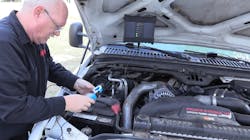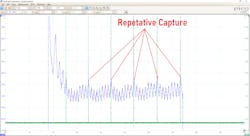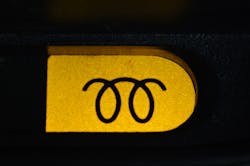Diagnosing a 'no start' on a diesel (6.0-liter Ford Powerstroke)
When you’re dealing with a no-start complaint on a gas engine, you only have three things to check:
- Is it getting fuel?
- Is it getting spark?
- Can the engine compress the air/fuel mix?
But on a diesel, it’s another story. The first major difference is that there is no spark plug. Diesels are compression ignition engines. They rely on high compression pressure to heat the air/fuel mix to the point of combustion. This 6.0, for example, has a compression ratio of 18:1 as compared to a typical gasoline engine ratio of 10: to 13:1.
Diesel fuel injection system
Another major difference is that most types of diesel engines don’t use a throttle plate. The amount of air going in is relatively constant. What causes the change in rpm is the amount of fuel injected, just prior to the pistons reaching TDC on their respective compression strokes. Even the operation of the injectors is different. This Ford, for example, uses a hydraulically actuated electronic unit injector, or HEUI injector.
This unique design uses high-pressure oil to pressurize the fuel charge in the injector. The high-pressure oil fills a cavity above a plunger (called the intensifier plunger), and this in turn, applies force on fuel contained in the fuel cavity in the nozzle of the injector. Once fuel pressure is great enough to overcome the force of the spring on the nozzle valve, the nozzle valve lifts from its seat, and fuel is atomized through the injector nozzle and is injected into the combustion chamber.
These injectors also require a substantial voltage to open the poppet valve that allows the high-pressure oil in. This is the responsibility of the Fuel Injector Control Module or FICM.
No-start, engine-mechanical factors?
The first step is to make use of what God gave you - your senses and your mind. In this case, attempt to crank the engine and listen carefully to the cadence as it spins.
- Is it turning over at a normal speed?
- Does it sound like the cylinders are pushing back as they are being pushed up by the crankshaft?
An engine with low or no compression makes a noticeably different sound when attempting to start it. Testing compression on a diesel is no easy task if you use a conventional method. But a technique I use all the time on gas engines may help here. It’s called the relative compression test and uses changes in starter current draw to gauge the amount of pressure being generated in each cylinder (Figure 1).
The idea is simple enough. The starter has to work against any mechanical resistance applied to it. If a cylinder is building high pressure, the starter current draw will be higher than it would be for a cylinder that isn’t. This can be monitored easily on a lab scope using an amp probe, as this is not an invasive test. No need to disturb any circuits. You can see these same variations in the changes in battery voltage if you don’t have a high amp clamp. Current flow and voltage drop go hand-in-hand. Relative compression amperage humps (or voltage-drop humps) that are relatively even and show adequate load on a starter should leave you confident that the cause of the no-start isn’t a mechanical problem (Figure 2).
By eliminating an engine mechanical fault quickly and easily, you would then move on to the next step. Verify the engine oil level and condition. A low oil level can allow air into the High-Pressure Oil Pump and on into the injectors, preventing them from injecting fuel into the cylinder. It can also lead to injector damage. Keeping the oil full and clean is a key maintenance item on any diesel engine.
A steady and clean fuel supply is also critical to diesel operation. Many diesels using common rail systems (using conventional electromagnetic or piezoelectric injectors) use a low-pressure lift pump to supply fuel to a high-pressure pump. The Ford also uses a low-pressure pump (with a fuel pressure specification of 45 psi) to supply the injectors via a split port feed. It also uses two fuel filters and maintaining them is critical to injector operation. Just like low oil, interruptions in the fuel feed to the injectors will cause drivability issues, loss of power, and injector damage. And diesels hate water in their fuel. Be sure to check the fuel for signs of water contamination or a “Water in Fuel” warning message on the instrument panel.
Adequate source voltage supply?
If oil and fuel are correct, the next step is to check the batteries. Low battery voltage can cause a slow crank condition and/or may contribute to Fuel Injector Control Module failure. It takes a starting rpm of approximately 180 - 200 rpm to generate sufficient heat in the air charge and start the engine. If the batteries pass but the engine still cranks slowly or intermittently, then perform a voltage test on the connecting cables before condemning the starter.
Now it’s time to connect the scan tool. First, perform a full system scan to see what DTCs may be stored and in which nodes. DTCs for glow plug faults in certain situations can be a clue to a no-start or hard-start (extended cranking) when the temperature is on the cold side. Glow plugs are used to preheat the air charge and assist in getting the air up to the temperature needed. That’s why you see a symbol on the dash or a “Wait To Start” message (Figure 3).
If white smoke is present while cranking, a glow plug system issue is a possibility, especially if I lived in a colder climate. The smoke is caused by fuel being injected into the cylinders but there isn’t enough heat being generated to support combustion. If no smoke is present while cranking, the glow plug system isn’t the culprit, but I’ll certainly want to address any glow plug-related DTCs and the needed repairs with my customer.
Next, monitor the data PIDs in the ECM’s data stream that are critical to the proper operation of the injection system. While attempting to start the engine, here are the specific PIDs I need:
- Cam/Crank Synchronization
- Injector Control Pressure Regulator (IPR)
- Injector Control Pressure (ICP)
- Injector Control Pressure Desired
- Fuel Injector Control Module (FICM) Injector Voltage
- Fuel Injector Control Module Synchronization
Here is what to look for:
- Checking Cam/Crank synch is one of the first no-start PIDs to look at, diesel or gas. If the ECM thinks the two are out of time, it may not allow the engine to start, to prevent engine damage.
- Earlier, I told you that the HEUI injectors used in the 6.0 rely on high-pressure oil to pressurize the fuel in the injector to the point needed to open the poppet valve. A minimum 500 psi injector control pressure is necessary to start the 6.0L Power Stroke diesel. If oil pressure does not reach or drops below 500 psi an injector will not fire.
- ICP typically reaches anywhere between 800 and 2,000 psi while cranking. If the ICP sensor reading is low, erratic, rises slowly while cranking, or there is another reason to suspect it is bad unplug the sensor and attempt to start the engine. The ICP defaults to 750 psi when the sensor is unplugged). If the engine starts, the ICP sensor must be replaced.
- The IPR duty cycle relates to the position of the IPR valve. At 15% duty cycle, the IPR valve is fully open. At 85% duty cycle, the IPR valve is fully closed. In the closed position, oil pressure is increased and in the open position, oil pressure is reduced (HPOP pressure bled off into the crankcase).
Let’s start the engine again and graph the PIDs so we can see the relationship between them.
- While cranking, IPR duty cycle should start at approximately 85% and slowly decrease during a long crank condition once ICP climbs. An IPR valve defaults to 15% if it is unplugged or has failed. In this instance, an engine will not start as it will not be able to build oil pressure and a low ICP condition should be present.
- IPR valve duty cycle should not exceed 30% at idle once the engine reaches operating temperature. If it does, suspect a leak in the high-pressure oil circuit.
- Any PID you see that has the word “Desired” at the end of it is the target value the programmer wants the module to reach by actuating the system or component it controls. In this case, ICP actual will tend to trail ICP desired while cranking, but the two should generally be close.
- If ICP desired is significantly higher than ICP actual the IPR valve may not be functioning correctly and is allowing oil pressure in the high-pressure circuit to bleed off. A high-pressure system leak or bad high-pressure oil pump can also cause a low ICP condition. But always verify IPR function before assuming a high-pressure oil system leak or HPOP failure.
- FICM voltage and synch are also critical to starting and drivability on the 6.0. 45 to 48 volts is acceptable. Anything lower than 45 and the internal capacitors have failed and need to be replaced. Fortunately, you can buy these in the aftermarket as a separate component rather than having to replace the entire module. If the FICM output voltage is 0, check the FICM vehicle power relay and replace the FICM relay when replacing the capacitors regardless of the condition.
- FICM sync should read a "1" bit (1 for yes, 0 for no) while the engine is being cranked or running. A "yes" or "1" value for FICM sync indicates that the FICM is receiving CPS/CKP signals from the ECM. If FICM sync returns a "0" or "no" value, CPS/CKP signal is not being transmitted to the FICM. Verify sensor conditions, connectors, and all wiring to the ECM and FICM.
If the injectors seem to have everything that they need to work but you are still having no start or rough running issues, the next step is to perform an injector “buzz” test. An injector "buzz" or "click" test is performed to identify a bad injector or injectors by means of an audible test. When an injector buzz test is initiated, the engine will sequentially activate each individual injector solenoid, producing buzzing and clicking sounds as the solenoids are energized.
All injectors should produce the same characteristic buzz/clicking sound; any injector that sounds different from the rest should be inspected and may require replacement. Just a word from experience. If you have to replace one injector, bite the bullet and replace them all. You’ll be glad you did. If no injectors buzz once the test is initiated, retest the FICM.
We’ve covered a lot, but I want to let you know about one more tool you can use to help you when diagnosing diesel or gas drivability issues. It’s called a cylinder contribution or power balance test. This test is used if the engine can be started. If the mechanical condition of the engine has been proven, this test can help determine how each individual injector contributes to engine rpm following an injection event. A weak injector will not contribute as much as a strong injector and thus engine rpm will decrease after that injector is fired.
Here’s a tip:
The FICM automatically adjusts injector pulse width to account for variances between injection event strength. This function must be briefly turned off to perform this test. You can do this by going to the bidirectional controls for the injectors. Select one but DO NOT actually disable it. This will give you roughly 1 minute to initiate the power balance test before the automatic pulse width adjustment function returns.
No doubt, diagnosing even a simple no-start on a diesel is a little different than what you may be used to if you have a gasoline engine background. But in the end, it still has to do the same thing - have fuel, compression, and a way to start the burn!
About the Author
Pete Meier
Former Creative Director, Technical | Vehicle Repair Group
Pete Meier is the former creative director, technical, for the Vehicle Repair Group with Endeavor Business Media. He is an ASE certified Master Technician with over 35 years of practical experience as a technician and educator, covering a wide variety of makes and models. He began writing for Motor Age as a contributor in 2006 and joined the magazine full-time as technical editor in 2010. Pete grew the Motor Age YouTube channel to more than 100,000 subscribers by delivering essential training videos for technicians at all levels.
Connect with Pete on LinkedIn.




